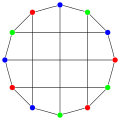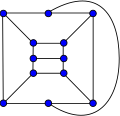| Bidiakis cube | |
|---|---|
 The bidiakis cube | |
| Vertices | 12 |
| Edges | 18 |
| Radius | 3 |
| Diameter | 3 |
| Girth | 4 |
| Automorphisms | 8 (D4) |
| Chromatic number | 3 |
| Chromatic index | 3 |
| Properties | Cubic Hamiltonian Triangle-free Polyhedral Planar |
| Table of graphs and parameters | |
In the mathematical field of graph theory, the bidiakis cube is a 3-regular graph with 12 vertices and 18 edges. [1]




